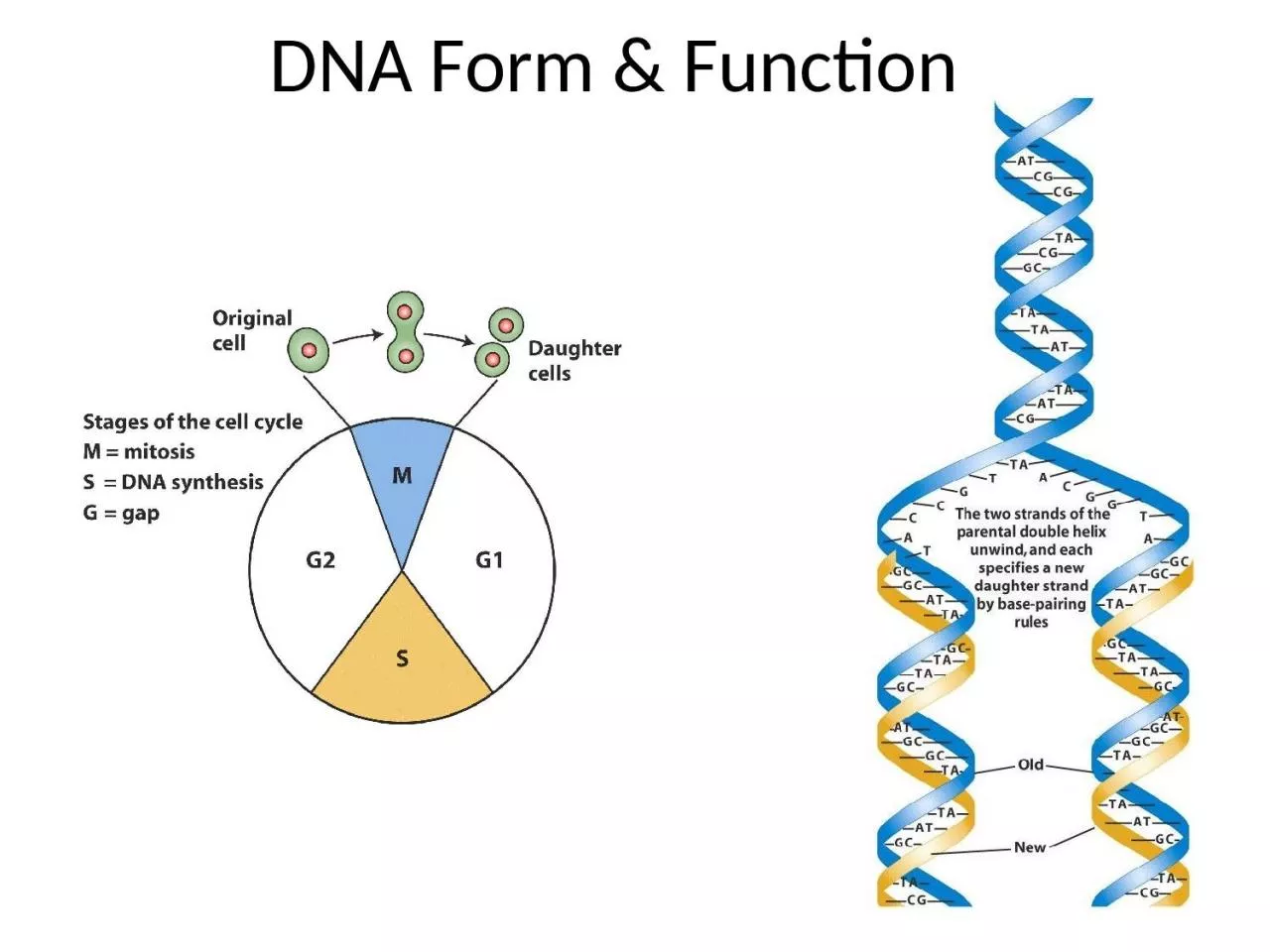

Understanding DNA structure and replication is a prerequisite for understandingusing the principal tools of molecular biology R R 0 R0 R0 0 R0 R0 R 0 R RR R0 0 R0 00 DNA Structure amp Replication ID: 916506
Download Presentation The PPT/PDF document "DNA Form & Function Understanding DN..." is the property of its rightful owner. Permission is granted to download and print the materials on this web site for personal, non-commercial use only, and to display it on your personal computer provided you do not modify the materials and that you retain all copyright notices contained in the materials. By downloading content from our website, you accept the terms of this agreement.
Slide1
DNA Form & Function
Slide2Understanding DNA replication – and the resulting transmission of genetic information from cell to cell, and generation to generation – lays the groundwork for understanding the principles of heredity
Understanding DNA structure and replication is a prerequisite for understanding/using the principal tools of molecular biology
R
R0R0R00R0R0
R0RRRR00R000
DNA: Structure & Replication
Slide3Three features of DNA makes it an ideal genetic material
Faithful replication
Information content
Capable of change
DNA: Structure & Replication
Slide4Overall structure
http://users.rcn.com/jkimball.ma.ultranet/BiologyPages/N/Nucleotides.html
DNA: Nucleotides
Slide5http://users.rcn.com/jkimball.ma.ultranet/BiologyPages/N/Nucleotides.html
Bases
DNA: Nucleotides
Slide6http://users.rcn.com/jkimball.ma.ultranet/BiologyPages/N/Nucleotides.html
Bases
DNA: Nucleotides
The combination of a base and a pentose sugar is a
nucleoside
Slide7http://users.rcn.com/jkimball.ma.ultranet/BiologyPages/N/Nucleotides.html
Nucleotide + Nucleotide + Nucleotide + ……
DNA: Polymerization
Slide8Complementary base pairing and the double helix
Replication is semi-conservative
DNA: Replication
Slide9DNTPs:
dATP
,
dGTP
, dTTP, and dCTP T
emplate DNA (a pre-existing single strand) DNA polymerase http://users.rcn.com/jkimball.ma.ultranet/BiologyPages/N/Nucleotides.html
DNA: Synthesis Essentials
1. DNTPs
Slide10ATCGGTCAACGTTAAAGTTAGCGG
DNA: Synthesis Essentials
2. Template DNA (a pre-existing single strand)
Slide11There are multiple forms of DNA polymerase
Different forms have different activities
Replicases
have direct roles in replication
Others have secondary roles in replication and/or repair synthesis. DNA replication – polymerization of deoxyribonucleotidesPolymerases catalyze the formation of a phosphodiester bond between the 3'-OH of the deoxyribose on the last nucleotide and the 5' phosphate of the
dNTP precursorProcess is repeated forming a synthesized DNA chainDNA: Synthesis Essentials
3. DNA Polymerases
Slide12Polymerase binds
to the DNA
template strand and moves along as the synthesized polynucleotide
chain grows
At each template base, the dNTP precursor is identified that can base pair with itThe frequency of error is low, but errors can occur. Polymerases can have exonuclease activity (removal of nucleotides from the 3' end of the chain)This
is a proof-reading mechanismAn unpaired nucleotide from the 3'OH end of the growing chain triggers exonuclease activityThe unpaired nucleotide is cleaved from the end of the growing chain by the polymerase. DNA: Synthesis Essentials
3. DNA Polymerases (continued)
Slide13DNA: Synthesis Essentials
Replication is 5’ to 3’
Slide14DNA: Synthesis Essentials
Replication is 5’ to 3’
Slide15DNA: Synthesis Essentials
Replication is 5’ to 3’
Slide16DNA: Synthesis Essentials
Replication is 5’ to 3’
Slide17DNA: Synthesis Essentials
Replication is 5’ to 3’
Slide18DNA: Synthesis Essentials
Replication is 5’ to 3’
Slide19Replication begins at a fixed point, called the origin, and proceeds bi-directionally. In a higher plant chromosome there are thousands of origins.
Consider
The size of the genome
The rate of DNA replicationThe length of the S phase
DNA Replication: 1-Origins
Slide20DNA Replication: 1-Origins
Slide21DNA Replication: 1-Origins
Slide22DNA Replication: 1-Origins
Slide23DNA Replication: 1-Origins
Slide24Unwinding:
The DNA helix needs to be opened up. This is accomplished by helicase enzymes, which break the hydrogen bonds holding the two strands of the helix together.
Gyrase
facilitates helicase action by relieving tension in coiled DNA
Stabilization: The unwound DNA is stabilized by a protein (single strand binding protein (SSB)), which speeds up DNA replication. http://www.dnareplication.info/stepsofdnareplication.phpReplication: 2-Unwinding, 3-Stabilization
Slide25Primases
form a short RNA primer
DNA polymerases use the
primer to
synthesise a new chainPolymerases cannot start synthesis on their ownRNA primers subsequently removed by exonuclease activity of a polymerase and replaced with DNA
http://www.dnareplication.info/stepsofdnareplication.phpReplication: 4 - Priming
Slide26DNA polymerases synthesize new chains only from 5' to 3‘
DNA molecule is antiparallel and DNA synthesis is semi-conservative.
DNA synthesis is continuous on 5’-3’ strand - leading strand
Synthesis discontinuous on 3’-5’ strand - lagging strand
Multiple priming sites on the lagging strandDNA therefore formed in fragments on lagging strand - Okazaki fragmentshttp://www.dnareplication.info/stepsofdnareplication.phpReplication: 5 – Leading & Lagging Strands
Slide27Replication: 5 – Leading & Lagging Strands
Slide28Replication: 5 – Leading & Lagging Strands
Slide29Replication: 5 – Leading & Lagging Strands
Slide30Replication: 5 – Leading & Lagging Strands
Slide31Replication: 5 – Leading & Lagging Strands
Slide32Replication: 5 – Leading & Lagging Strands
Slide33Replication: 5 – Leading & Lagging Strands
Slide34DNA
Pol I exonuclease
removes RNA Primers in lagging strandDNA Polymerase adds
complementary nucleotides to fill the gapsDNA Ligase adds phosphate in the remaining gaps of the phosphate - sugar backboneCan’t backfill RNA primer site at telomere of lagging strandTelomere shortening during replicationRole of TelomeraseReplication: 6 Termination
Slide35The telomerase solution
https://
www.youtube.com/watch?v=vtXrehpCPEE
Slide36Mis-matched bases can be added in error during polymerization
Specific polymerases with 3’-5’
exonuclease activity identify and remove any detected mis-matches on the synthesized strandProofreading starts at the 3' end of the synthesized strand and proceeds 3’ -> 5’
Two exact copies of original, each with one original and one new strandReplication: 7 Proof-Reading